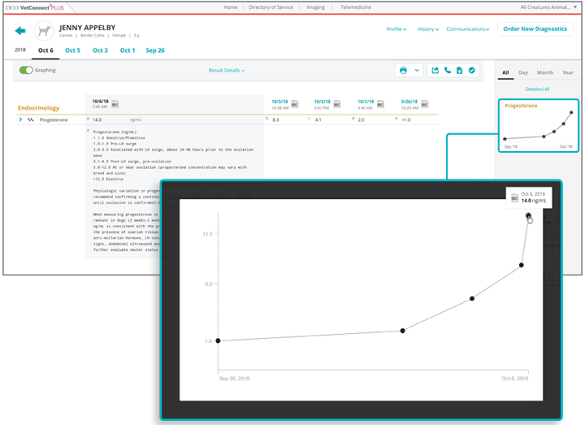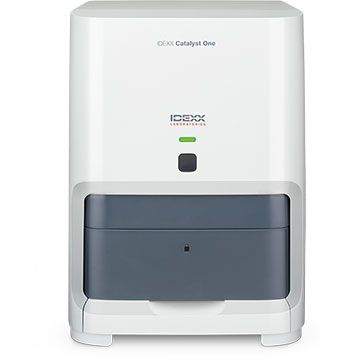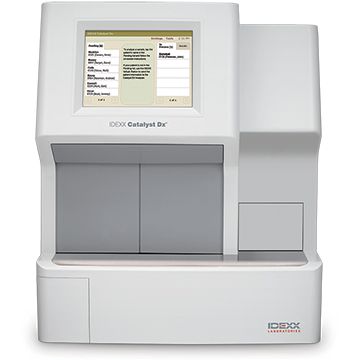
Catalyst Progesterone
Reliably predict canine ovulation with quantitative results in real-time
- Share results during the visit. From whole blood to results in 12 minutes.
- Count on precision and accuracy. Excellent correlation (r = 0.98) with the gold standard (LC-MS).
- Easily identify progesterone surges. Graph results and spot trends quickly using VetConnect PLUS.
How to run Catalyst Progesterone
Running progesterone on a Catalyst One Chemistry Analyser
- Enter the sample information on the IDEXX VetLab Station.
- Load the slide, sample, and reagent.
- Close the sample drawer and press the Start button on the analyser.
Running progesterone on a Catalyst Dx Chemistry Analyser
- Enter the sample information on the IDEXX VetLab Station.
- Select the patient and sample type on your Catalyst Dx Chemistry Analyser.
- Load your sample and the progesterone slide.
- Load the reagent and tap Run on the analyser.
Performance
Dr. Graham Bilbrough’s white paper provides details about the correlation of Catalyst Progesterone to the reference method and the test’s precision in the range of clinical interest.

Your guide to serial monitoring with Catalyst Progesterone
Don’t miss the breeding window. Use quantitative, in-house results to reliably predict ovulation and estimate optimal fertility.
Ovulation and time of optimal fertility can be estimated by observing a distinct rise in progesterone concentrations, which is best identified with serial testing.
|
Phase |
Progesterone concentration |
Recommended action |
|||||||||||
|---|---|---|---|---|---|---|---|---|---|---|---|---|---|
|
Anestrus/ proestrus |
<1.0 ng/mL |
 |
Retest in 2–4 days |
 |
 |
||||||||
|
Pre-LH* surge |
1.0–1.9 ng/mL |
 |
Retest in 2–3 days |

|
 |
||||||||
|
LH surge |
2.0–3.0 ng/mL |
 |
Retest in 1–2 days |

|
 |
||||||||
|
Post-LH surge/ preovulation |
3.1–4.9 ng/mL |
 |
Retest in 1–2 days |

|
 |
||||||||
|
At or near ovulation |
5.0–12.0 ng/mL |
 |
Determine breeding schedule |
 |
|||||||||

- Obtain a baseline measurement of progesterone and vaginal cytology at first signs of heat.
- Increase frequency of progesterone testing when 75% of cornified superficial cells are noted on vaginal cytology (typically 3–4 days after a bloody vulvar discharge is noted).
- Confirm a definitive and continued rise above 5.0 ng/mL to assess time of ovulation.
- Determine breeding schedule based on desired method of insemination and semen type.
Important note: The above are guidelines, and individual dogs may vary. Progesterone is best used in conjunction with other monitoring techniques, such as observation of clinical signs, vaginal cytology, vaginoscopy, ultrasound, and additional hormonal testing.
Related products
Get the most out of Catalyst Progesterone

Fast, accurate results
See results for SDMA, total T4, chemistry, electrolytes, and more, in one run with the Catalyst One Chemistry Analyser .

Multiple samples in minutes
Results for SDMA, total T4, chemistry, electrolytes, and more, for multiple patients with the Catalyst Dx Chemistry Analyser .
Support
Customer service
For further enquiries please contact our customer service team on
0800 838 522
iCARE
Keeping your practice up-to-date and running smoothly is the iCARE promise . We’re at your service 24 hours a day, seven days a week to help you deliver the best veterinary care and customer experiences possible.
Order tests & supplies
Learn more about ordering direct from IDEXX and order your in-house tests and supplies today.
*LH is luteinizing hormone.